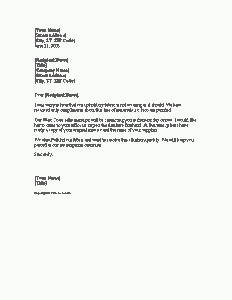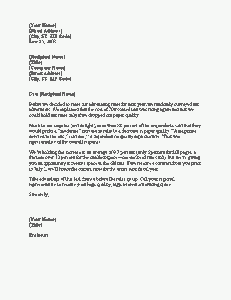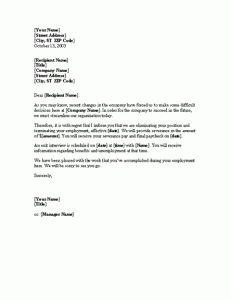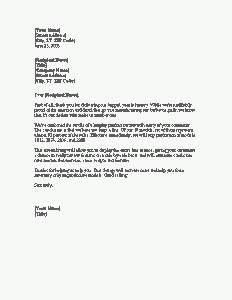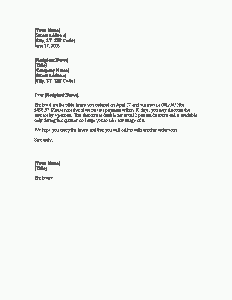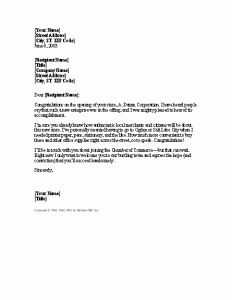9 Ready-To-Use Falsifying Information Termination Notice Template
Welcome to our comprehensive collection of termination letter templates. We understand that dealing with employee misconduct and termination can be challenging for employers. These templates are designed to provide you with a starting point and guidance in addressing various misconduct scenarios, ensuring fairness, legality, and adherence to best practices. Whether you are facing issues related to falsifying information, breaches of confidentiality, fraudulent behavior, or other serious violations, these templates can assist you in navigating the termination process effectively. Remember to customize them to fit your specific circumstances and consult with legal professionals or HR experts for advice. With these resources at your disposal, you can handle terminations with professionalism, protect the interests of your organization, and maintain a respectful and supportive work environment.
#1: Misrepresentation of Facts:
Misrepresentation of facts occurs when an employee deliberately provides false or misleading information regarding their educational credentials, work experience, or qualifications, either during the hiring process or while already employed. Such actions undermine the trust and integrity necessary for effective recruitment and maintaining a qualified workforce. Employers rely on accurate information to make informed decisions, and any intentional misrepresentation can lead to severe consequences, including termination of employment. It is essential for employees to uphold honesty and transparency throughout their professional journey to ensure a fair and trustworthy working environment.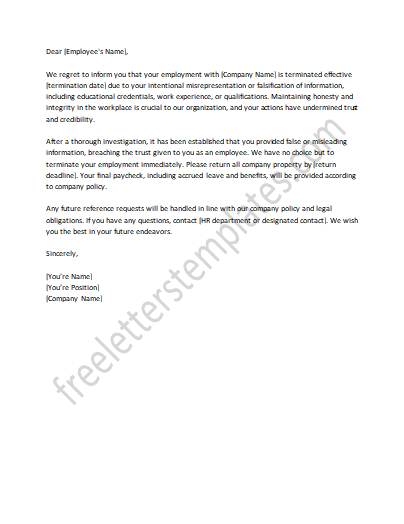
#2: Fraudulent Documentation:
Fraudulent documentation occurs when an employee knowingly presents fraudulent or doctored documents to support their qualifications or claims. This includes submitting falsified degrees, certifications, or licenses. Such actions erode the trust between the employee and the organization and can have serious consequences for both parties involved. Employers rely on accurate and trustworthy documentation to make informed decisions during the hiring process and throughout employment. Any form of fraudulent documentation not only undermines the integrity of the employee but also jeopardizes the reputation and credibility of the organization. It is essential for individuals to maintain honesty and integrity by providing genuine and verifiable information regarding their qualifications and credentials.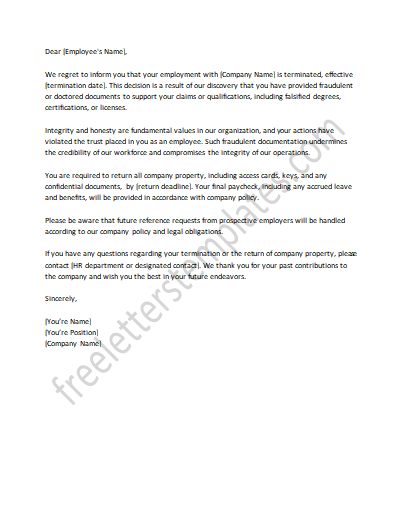
#3: Manipulation of Records:
Manipulation of records refers to the deliberate act of an employee altering or manipulating official records, such as financial statements, customer data, sales reports, or any other essential documentation. This behavior is characterized by the intent to deceive or misrepresent information. Such actions undermine the trust and integrity that organizations rely on to make informed decisions. The accuracy and reliability of records are critical for maintaining transparency and ensuring the smooth functioning of business operations. Any form of record manipulation not only compromises the credibility of the employee but also poses significant risks to the organization’s reputation and legal compliance. It is crucial for employees to uphold ethical standards and maintain the integrity of records, as trust and accuracy are the cornerstones of a successful and trustworthy work environment.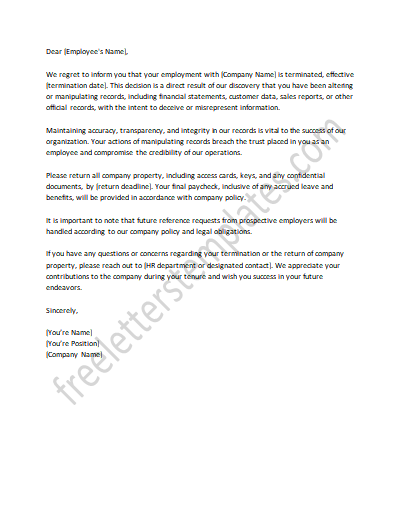
#4: False Reporting:
False reporting occurs when an employee knowingly provides false or misleading information in reports, time sheets, expense claims, or any other official documentation. This deliberate action undermines the integrity and reliability of the information presented. Trustworthy and accurate reporting is essential for informed decision-making and maintaining the smooth functioning of an organization. Intentionally providing false or misleading information compromises the transparency and credibility that employers rely on. It is crucial for employees to uphold honesty and integrity in their reporting, as misleading or false information can have detrimental effects on the organization’s operations, trust, and overall success.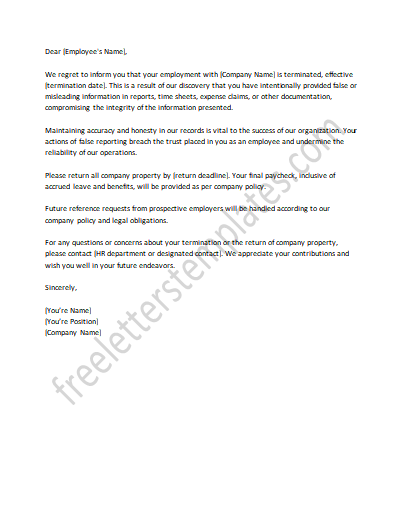
#5: Breach of Confidentiality:
Breach of confidentiality refers to the violation of an employee’s obligation to protect sensitive and confidential information. However, when an employee goes beyond breaching confidentiality obligations and also engages in falsifying or manipulating confidential information, it further erodes the trust and integrity within the organization. Confidentiality is a fundamental aspect of maintaining the privacy and security of sensitive data, and any breach can have severe consequences for both individuals and the organization as a whole. Falsifying or manipulating confidential information not only compromises the trust placed in the employee but also poses significant risks to the organization’s reputation, legal compliance, and relationships with clients or partners. Upholding strict confidentiality standards and treating sensitive information with the utmost care and respect are crucial to maintaining a trustworthy and secure work environment.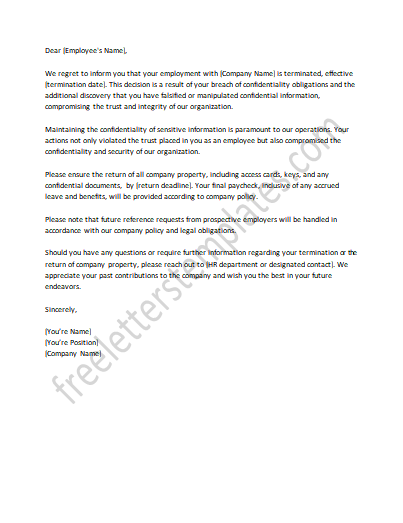
#6: Fabricated Performance Data:
Fabricated performance data refers to the act of an employee intentionally creating or falsifying performance data, metrics, or achievements to misrepresent their actual contributions and performance within the company. Such actions undermine the transparency and fairness that organizations rely on to assess employee performance and make informed decisions. Fabricated performance data not only misrepresent an individual’s true abilities but also disrupts the trust and integrity of the entire performance evaluation process. Accurate performance data is crucial for effective performance management, career advancement, and equitable recognition within the organization. Employees are expected to uphold honesty and integrity when reporting their achievements and contributions, as it is essential for maintaining a reliable and merit-based work environment.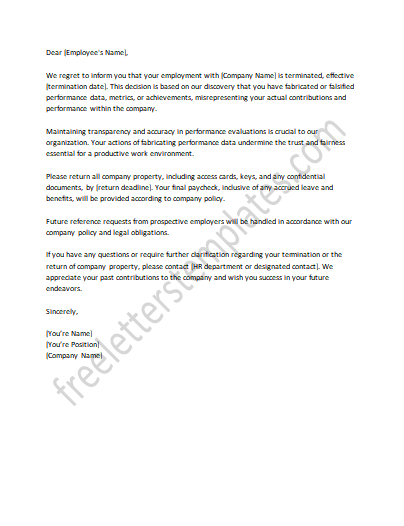
#7: False Statements to Authorities:
False statements to authorities occur when an employee knowingly provides false or misleading statements or information to regulatory bodies, government agencies, or law enforcement officials. This misconduct can have serious implications, not only for the employee but also for the organization as a whole. Providing false statements undermines the trust and integrity necessary for effective cooperation with authorities and adherence to legal obligations. It is crucial for employees to understand the importance of truthfulness and accuracy when interacting with regulatory bodies and government agencies. Misrepresenting information can lead to severe legal consequences for both individuals and the organization. Upholding ethical standards and providing truthful information are vital for maintaining a strong legal standing and preserving the reputation and credibility of the organization.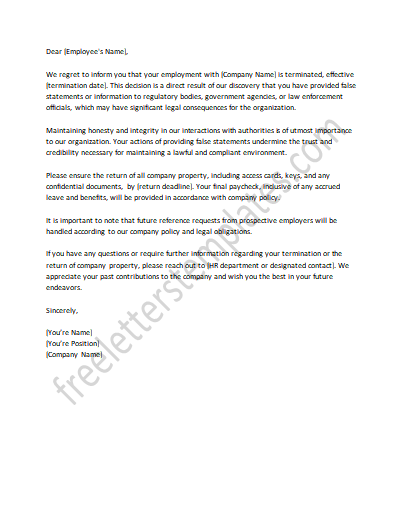
#8: Academic Dishonesty:
Engaging in academic dishonesty, such as plagiarism, cheating, or submitting fraudulent academic credentials, goes against the ethical standards we hold dear in the workplace. When an employee is discovered to have committed such acts, it not only reflects a breach of personal and professional integrity but also undermines the trust and confidence placed in them by their colleagues and the organization as a whole. Upholding academic integrity is vital for fostering a culture of honesty, fairness, and mutual respect within our work environment. We value individuals who demonstrate integrity in their academic pursuits and uphold ethical standards, as it ensures a level playing field, builds trust, and upholds the credibility of our organization.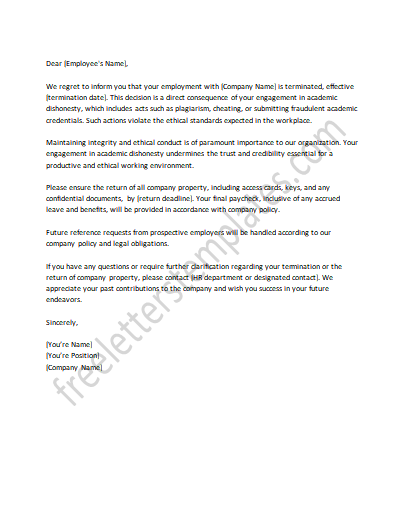
#9: Inaccurate Customer Data:
Use this template when an employee has been found to have deliberately manipulated or falsified customer data, such as contact information, purchase history, or feedback, which can lead to detrimental effects on customer relationships and business operations.
Deliberately manipulating or falsifying customer data, such as contact information, purchase history, or feedback, has serious consequences for customer relationships and our business operations. Accurate and reliable customer information is vital for our interactions and decision-making. This misconduct undermines trust, hampers our ability to provide exceptional service, and jeopardizes our reputation. Upholding honesty and accuracy in managing customer data is crucial for building strong relationships and ensuring the smooth functioning of our business. Each employee must prioritize the integrity of customer data.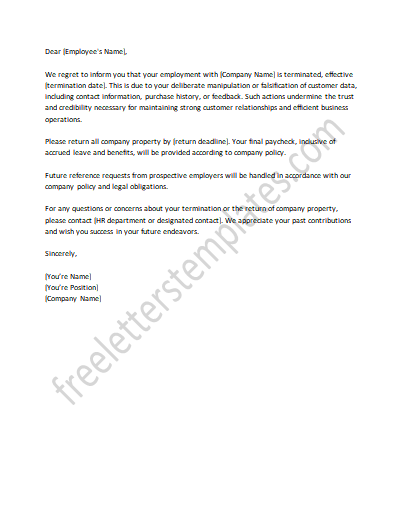
Overview of the Termination Process
Investigation: Before initiating the termination process, it is crucial to conduct a thorough investigation to gather all relevant facts and evidence related to the alleged misconduct or performance issues. This may involve interviewing relevant parties, reviewing documentation, and ensuring due process.
Reviewing Policies and Contracts: The employer should carefully review the employment contract, company policies, and any applicable laws to ensure compliance during the termination process. This includes confirming grounds for termination, notice periods, severance pay (if applicable), and any other legal obligations.
Consultation with HR and Legal Professionals: It is advisable to involve HR professionals and, if necessary, legal counsel to ensure that the termination process follows legal requirements and company policies. They can provide guidance on handling sensitive situations, reviewing termination letters, and addressing any potential risks or challenges.
Documentation: Proper documentation is essential throughout the termination process. This includes maintaining records of the investigation, performance evaluations, disciplinary actions, and any communication related to the termination. Documentation helps support the reasons for termination and can be crucial if legal issues arise.
Notice and Communication: Once the decision to terminate an employee has been made, the employer must provide appropriate notice or pay in lieu of notice, as per employment agreements and applicable labor laws. The termination should be communicated to the employee in a respectful and professional manner, outlining the reasons for the decision and any relevant next steps.
Return of Company Property: The employee should be informed of the process for returning any company property, such as keys, access cards, laptops, or other equipment. This should be handled promptly and in compliance with company policies and legal requirements.
Final Payments and Benefits: The employer must calculate and provide the employee with final payments, including any outstanding wages, vacation pay, and other entitlements as per employment agreements or applicable laws. The termination may also impact benefits, such as health insurance or retirement plans, and the employee should be informed of any changes.
Post-Termination Support: Depending on the circumstances, it may be beneficial to provide post-termination support, such as assistance with job search, career counseling, or access to employee assistance programs. This can help ease the transition for the terminated employee and maintain a positive employer brand.
Conclusion
In conclusion, the templates provided on this website page offer guidance for employers facing employee misconduct and termination. Customize the templates to meet specific circumstances and seek advice from legal professionals and HR experts. Proactively foster integrity, provide comprehensive training, and implement effective conflict resolution policies. Handle terminations with fairness, sensitivity, and open communication, prioritizing the organization’s values and reputation. Remember, termination should be a last resort, approached professionally and respectfully. Utilize the resources available to navigate challenges while prioritizing employee well-being and maintaining a positive work environment.
← Previous Article
« Free 14-Creatively Crafted Service Complaint Resolution Letter Template